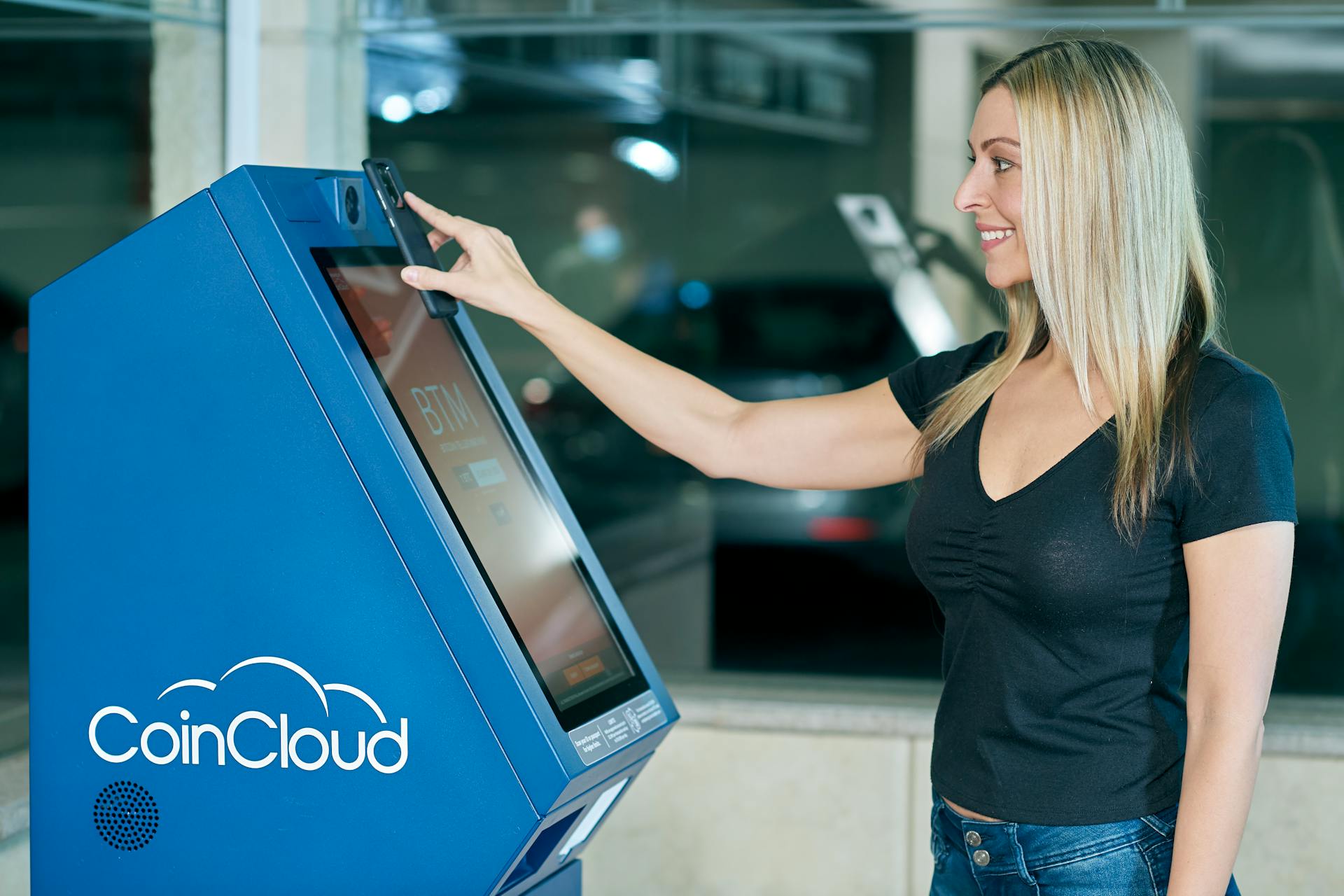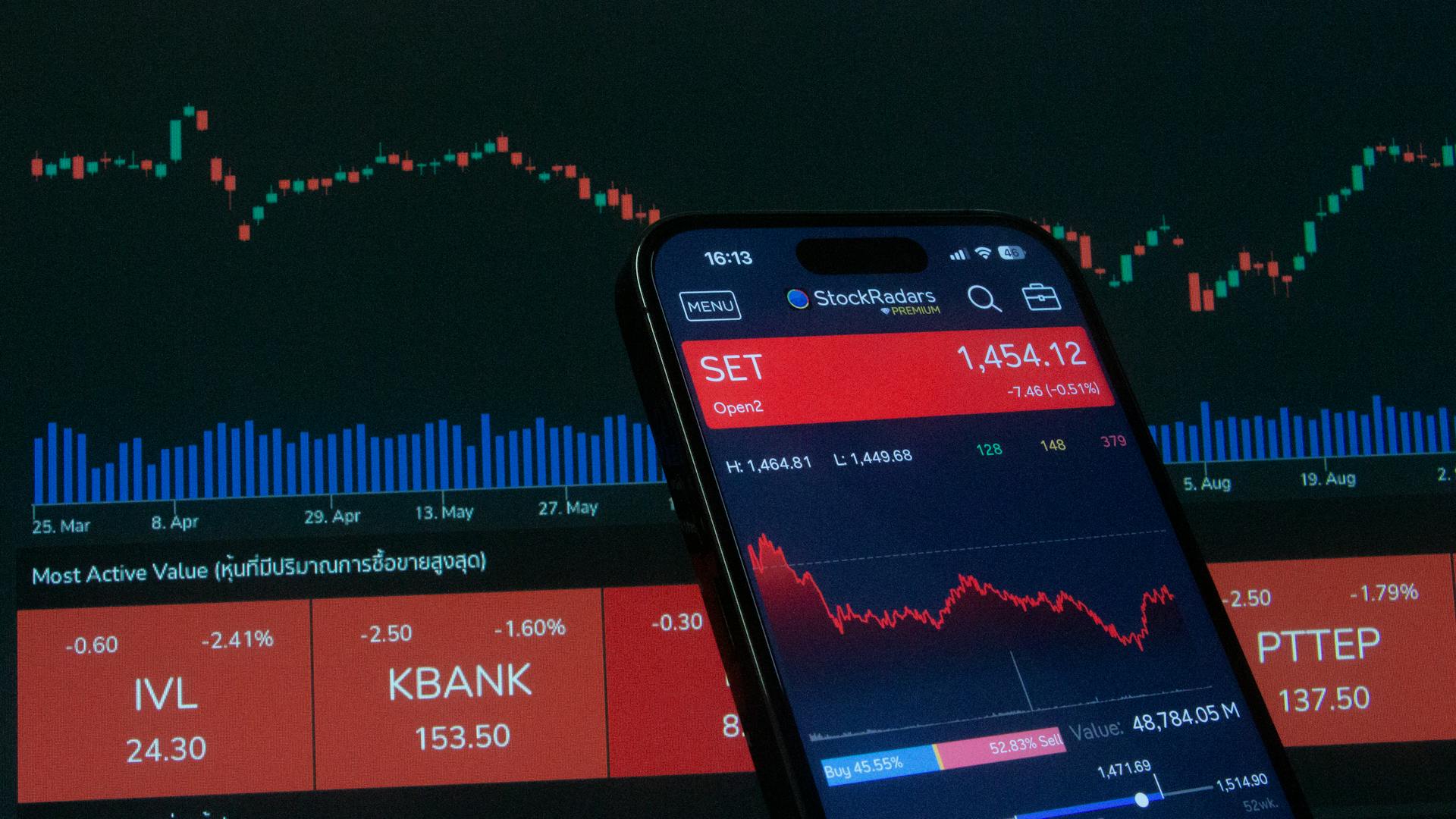
Traditional banking can be restrictive and expensive, but there are alternative options that can help you take control of your finances. Online banking platforms like TransferWise allow you to send and receive money across borders without the hefty fees associated with traditional banks.
Digital banking apps like Revolut and N26 offer fee-free spending and saving, making it easier to manage your money on the go. These apps are designed to be user-friendly and offer real-time account updates, so you can stay on top of your finances.
Cryptocurrencies like Bitcoin and Ethereum are also gaining popularity as alternative forms of currency. They offer a secure and decentralized way to make transactions, but it's essential to understand the risks and volatility involved before investing.
Explore further: In a Fractional Reserve Banking System Banks Create Money Because
What is Alternative Banking
Alternative banking offers a more flexible and non-traditional approach to financial services. Traditional banks often have strict requirements, but bank alternatives are less strict and cater to different needs.
A bank alternative typically provides remote services, which can be a game-changer for people who don't have access to traditional banking services.
Readers also liked: Alternative Bank Switzerland
What Is?
Alternative banking offers flexible and non-traditional financial services that cater to diverse customer needs.
A bank alternative is often less strict in terms of what they require from customers, making it easier for people to access financial services.
They typically provide remote services, allowing customers to manage their finances from anywhere in the world.
This can be especially helpful for people who live in areas with limited access to traditional banks or prefer to manage their finances online.
Bank alternatives may not have any public branches or provide in-person services, which can be a significant advantage for customers who value convenience and flexibility.
They may serve customers from around the world or focus on a small, specific community, making them a viable option for people with unique financial needs.
Poverty and Financial Services
Traditional banking systems often exclude low-income individuals due to lack of collateral or credit history, leaving them without access to financial services.
For example, in many developing countries, people may not have a formal address or identification, making it difficult for them to open a bank account.
This can lead to a cycle of poverty as they are unable to access basic financial services like savings, loans, and insurance.
In contrast, alternative banking models have been developed to provide financial services to underserved populations.
In some alternative banking models, savings groups are formed where members contribute a fixed amount of money on a regular basis, creating a pool of funds that can be used for loans or other financial services.
These types of savings groups can be an effective way to provide financial services to low-income individuals who may not have access to traditional banking systems.
See what others are reading: Green Finance Loans
History and Background
In March 2009, eleven ethical banks formed a global alliance to strengthen alternatives to the crisis-shaken conventional financial model. The Global Alliance for Banking on Values was launched in the Netherlands, with ABS as a founding member.
Related reading: Global Alliance for Banking on Values
The alliance included other notable members such as BRAC Bank from Bangladesh, Mibanco from Peru, and GLS Bank from Germany. Together, they aimed to promote solidar economic cooperation, long-term action, and responsible income.
As of 2009, the Global Alliance had about 12,000 million Swiss francs in assets and seven million customers in 20 countries. This demonstrates the significant impact that alternative banking can have on a global scale.
In 2016, ABS partnered with Oikocredit to offer a bank account that supports microfinancing, known as the Oikocredit-Förderkonto. This account helps finance partner organizations in over 70 developing and emerging countries.
By providing access to small loans, women can build up self-employment and small businesses can grow, promoting sustainable development and economic growth.
Recommended read: Swiss Bank Account
Types of Alternative Banking
Peer-to-peer banking is a great alternative to traditional banking, allowing you to make financial arrangements with people you know.
P2P banking services impose fewer requirements and offer better fees than traditional banks, thanks to the community-powered model.
With P2P lending, you can lend money to individuals and earn returns of about 5% to 10%, although you should be aware that lending accounts are not FDIC-insured.
Credit unions and online banks are also alternatives to traditional banking, often offering higher interest rates on savings accounts.
Credit unions are not-for-profit organizations that offer federally insured accounts through the National Credit Union Share Insurance Fund.
Online banks, such as Ally Bank or American Express Bank, offer higher interest rates on savings accounts and CDs due to lower overhead expenses.
Take a look at this: Chase Bank Warns Customers to Prepare for Higher Banking Fees.
Start-Ups
Start-ups can benefit from alternative banking options that make international transactions easier. P2P banking apps can help manage payments to/from international staff and clients from one account.
Peer-to-peer banking services impose fewer requirements and offer better fees than traditional banks, making them a cost-effective option for start-ups. This can be a significant advantage for businesses with limited resources.
Using P2P banking services can also help start-ups avoid the high fees associated with traditional banking. By leveraging a community of users, P2P services can provide lower fees and more flexible transaction options.
Here's an interesting read: Banks and Banking Services
Start-ups can also consider peer-to-peer lending services as an alternative to traditional financing options. These services allow individual lenders to fund loans, providing a unique opportunity for start-ups to access capital.
Individual lenders can choose to fund loans with as little as $25, making it easier for start-ups to access the capital they need. However, it's essential for start-ups to understand the regulatory environment around P2P lending and the risks involved.
If this caught your attention, see: Nigerian Capital Development Fund
Credit Unions
Credit Unions offer a great alternative to traditional banks. They are usually non-profit organizations and are often community-operated, which means they may provide better rates, fees, and terms of service.
Unlike traditional banks, credit unions often have physical branch locations and provide limited online banking features. This makes them a good choice if you need semi-traditional banking services.
Credit unions operate much the same as banks, although they typically offer fewer financial services. They commonly offer significantly better interest rates on savings accounts than banks do because credit unions are not-for-profit organizations.
Credit union accounts are federally insured through the National Credit Union Share Insurance Fund (NCUSIF), which provides an added layer of security for your money.
Overall, credit unions are a viable option for those looking for a more community-driven banking experience with potentially better rates and terms.
For your interest: Community Development Bank
Fintech
Fintech is a type of banking that's focused on financial technology, providing digital financial services. Most fintech banks only offer online services and don't have in-person branches.
Fintech banks can offer faster service and better rates than traditional banks, but this depends on how well they take advantage of digital finance. I've found that fintech banks can be a great option for those who are tech-savvy and comfortable with online banking.
Some fintech banks may provide a wide range of digital services, including payment services, which include services like sending and receiving money. Payset is a leading payment services company in the UK, offering services that allow users to make effortless and affordable B2B payments.
Payset also offers multi-currency accounts, which allow users to manage global payments and receive money in 34 different currencies. With a Payset multi-currency account, you can send money in up to 38 currencies, and even use various payment networks like SWIFT, SEPA, and ACH.
For your interest: Quickbooks Online Payments Bank to Bank
One of the benefits of using a fintech bank like Payset is that there are no transaction limits on their multi-currency accounts. However, higher-volume transactions may require additional anti-fraud verification. It's always a good idea to contact Payset in advance to avoid verification delays.
Payset's services are available in 180 countries, making it a great option for businesses and individuals who need to send money internationally. With a Payset account, you can also enjoy competitive exchange rates and hold your chosen currencies to capitalize on market movements.
Here are some key features of Payset's multi-currency account:
- Funds can be deposited and withdrawn from the account for a small fee.
- Account holders can send and receive money with other Payset users for free.
- Depending on your region, you can use various payment networks from your Payset account, including SWIFT, SEPA, ACH, Fedwire, Faster Payments, BACS, and CHAPS.
- Once you register an account, you will be provided with a Virtual IBAN (International Bank Account Number), which makes all of these transfers easy.
- We provide you with local payments and collections. For example, transactions in USD, EUR, CAD, and GBP are processed through the local payment networks, which is far cheaper and takes minutes as opposed to days.
Overall, fintech banks like Payset offer a convenient and cost-effective way to manage global payments and receive money in multiple currencies.
Pros and Cons
Alternative banking offers several advantages over traditional banking. Bank alternatives are open to customers with low credit scores or those living abroad.
One of the key benefits is that they often have better fees and terms, making them a more cost-effective option. This is because bank alternatives aim to compete with mainstream payment services.
Bank alternatives also provide greater convenience, allowing you to set up an account remotely without having to visit a bank branch in person. This can be a huge time-saver, especially for those with busy schedules.
Here are some of the key pros of bank alternatives:
- Fewer customer requirements
- Better fees and terms
- Greater convenience
- Better user experience
Negative Interest Rates
Negative interest rates were first introduced by the Swiss National Bank, which made Swiss banks pay an interest rate of 0.75% on their deposits as of the end of January 2015.
The ABS was the first bank in Switzerland to respond to this change by introducing negative interest rates for assets on the accounts of their retail banking customers. From 1 January 2016, customers had to pay 0.125% on their ordinary accounts for private payments.
The ABS also decided to pay no more interest on all settlement accounts as of 1 April 2015.
Expand your knowledge: Schweizerische Nationalbank
Pros and Cons
So you're considering using a bank alternative or a savings account? Let's weigh the pros and cons.
Bank alternatives have fewer customer requirements, making them more accessible to those with low credit scores or living abroad. They also offer better fees and terms, often with lower fees and more favorable service terms.
Bank alternatives provide greater convenience, allowing you to set up an account remotely without needing to visit a physical branch. This is especially helpful for those who are busy or have mobility issues.
Bank alternatives usually offer a better user experience, with streamlined apps that are easier to navigate than traditional online banking services.
On the other hand, bank alternatives have some drawbacks. They often provide only online services, which can be limiting for those who prefer in-person interactions.
Some bank alternatives also lack physical branches, relying on remote support through chat, email, or phone. This can be frustrating for those who need immediate assistance.
Bank alternatives may have less brand recognition, making it harder to choose a reputable service. This can be a concern for those who value security and stability.
Lastly, bank alternatives often don't have dedicated ATMs, making it difficult to withdraw cash without incurring high fees.
Choosing the Right Option for Me
Choosing the right option for you involves doing your research. You can use rating and review sites like Trustpilot and TheBanks.eu to compare different bank alternatives.
It's a good idea to try out multiple bank alternatives by storing a portion of your funds with each one. This will allow you to choose the service that best fits your needs.
A bank alternative is suitable for almost anyone, but it's especially useful for individuals who can't open a traditional bank account. This is because bank alternatives rarely refuse to serve individuals with no credit history or a poor credit score.
Some bank alternatives support a wide range of countries and currencies, making them ideal for individuals who travel, work abroad, or send and receive money internationally.
Before making a decision, take the time to realize what matters most to you. Do you prioritize the speed of transactions, flexible financing terms, or a close relationship with a financial provider?
Frequently Asked Questions
Why do people trust in alternative banking services?
People trust alternative banking services because they offer transparent and upfront pricing, helping to build trust with unbanked households. This transparency addresses a common concern that drives people away from traditional banks.
Sources
- https://en.wikipedia.org/wiki/Alternative_Bank_Switzerland
- https://www.payset.io/post/alternative-banking
- https://ecapital.com/blog/5-reasons-alternative-banking-helps-small-businesses-thrive/
- https://www.investopedia.com/articles/personal-finance/091815/5-best-alternatives-bank-saving-accounts.asp
- https://econreview.studentorg.berkeley.edu/banking-and-poverty-why-the-poor-turn-to-alternative-financial-services/
Featured Images: pexels.com


